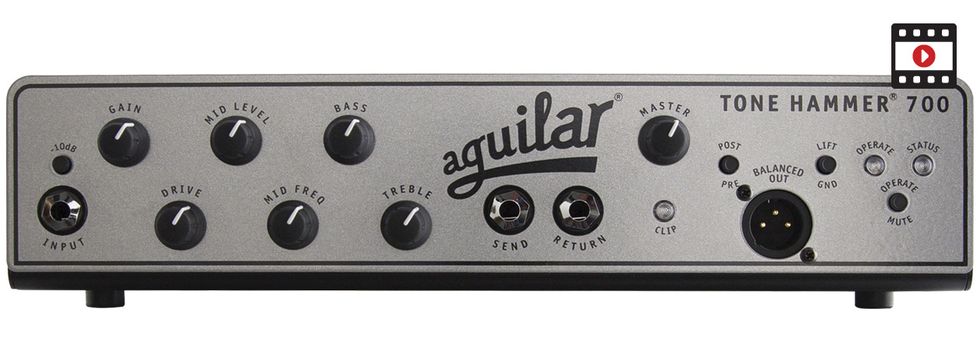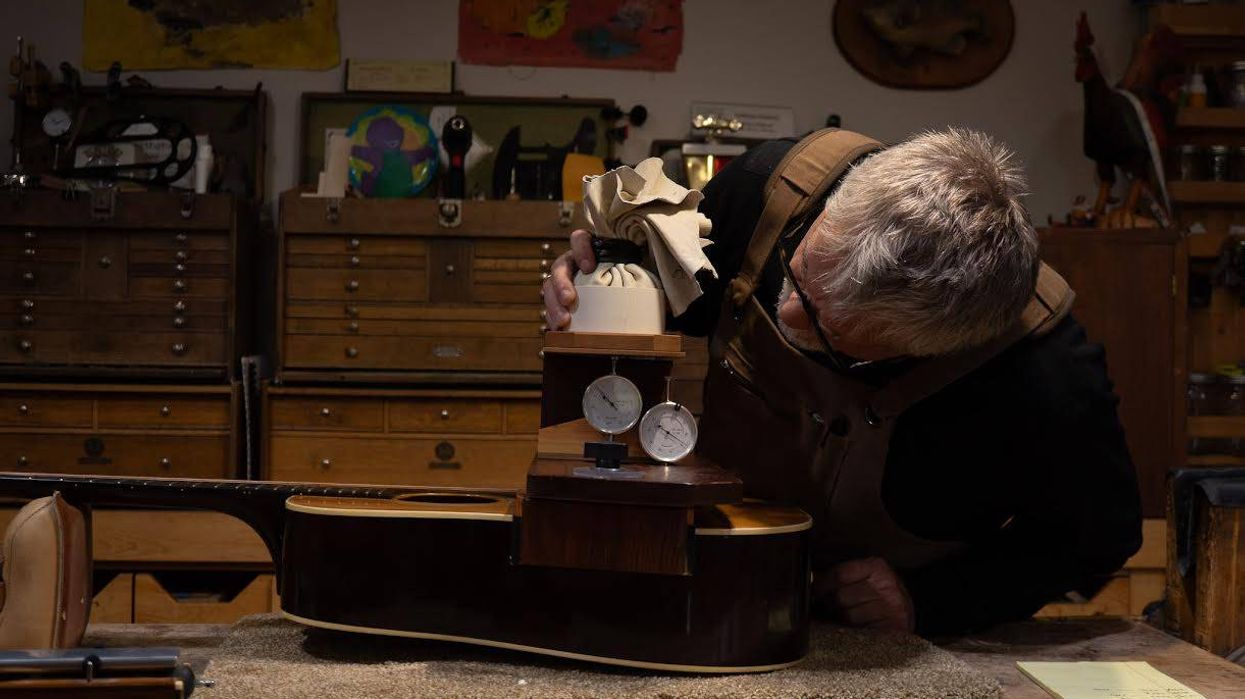Both clips recorded through an Avid Mbox into Logic X. Each clip begins with Mbox only (no amp in signal chain), then to Aguilar DI (pre), then to Aguilar DI (post).
Clip 1: ’79 Yamaha BB2000 with both P and J pickup engaged, drive knob at 1 o’clock, bass bump to 1 o’clock, mid cut to 11 o’clock, treble at noon, played with a pick.
Clip 2: Squire P bass outfitted with Kloppmann pickup, drive knob at 3 o’clock, bass at 1 o’clock, treble and mids flat, thumb-muted.
RatingsPros:Highly useable drive function. Lightweight. Versatile tones. Cons: Lacks an all-in-one EQ/tone knob. Could use a headphone out. A bigger and easier-to-spot mute button would be nice. Street: $899 Aguilar Tone Hammer 700 aguilaramp.com | Tones: Ease of Use: Build/Design: Value: |
Aguilar Amplification first joined the class-D revolution in 2011 by combining the preamp from their popular Tone Hammer pedal with a class-D power amp section for their Tone Hammer 500 head. And while today’s bass-amplification market is no doubt flush with lightweight, class-D-powered amps at fairly affordable price points, the Tone Hammer series has remained a staple for many bassists in widely different applications. The company’s newest class-D entry, the Tone Hammer 700, provides all the features a number of players have come to know and love, but Aguilar also added more of the feature that so many bassists know and love the most: power.
Familiar Face
The first thing that caught my attention after pulling the Tone Hammer 700 out of its shipping box was how incredibly light it is. At just shy of five pounds, the 700 is noticeably lighter than many others in its class. I might sound like an old guy here, but it’s still astounding to me that 700 watts can actually weigh less than a big, hardcover book.
Those already familiar with the Tone Hammer 500 will recognize the front plate—where the gain and drive controls, 3-band EQ, midrange-frequency selector, effect send/return, and DI out are placed in their tried-and-true positions. Around back, the rear panel is a simple affair with two Speakon speaker outputs, a tuner output, and the mains on/off switch located right above the power-cable connection.
Straight to Work
On the day the Tone Hammer 700 arrived at my house, I was booked to play a 1,000-capacity club here in Southern California. Along with my 20-year-old Sadowsky Vintage 5, I brought the Aguilar to run the Ampeg 8x10 house cabinet.
My first impression was how distinct the sound of the Tone Hammer is. The amp has a fingerprint that’s hard to miss when the EQ section is left untouched, and that fingerprint comes with a lot of mids. With the drive circuit barely engaged, at 9 o’clock, the feeling of tube simulation was instantly present, and I felt like the amp made for a good pairing with the large cabinet. With its 700 watts, I had no problem getting a commanding stage volume with the master volume set to 10 o’clock.
As a fairly aggressive player who keeps his electronics in passive mode about 90 percent of the time, I found myself cutting quite a bit of the mids and boosting the highs slightly to help make the bass clear and keep it from honking too much. I enjoyed the Tone Hammer’s definition with this setup, especially when playing fingerstyle. My tone never got too muddy, it provided plenty of attitude, and the amp’s slight tube simulation made slides with fret noises sound musical.
Back in my home studio, I put the Tone Hammer 700’s onboard DI through its paces with a 1983 Yamaha BB1600, which is like a slightly angrier Precision bass. I used a pick, which can present challenges when not miking a cab, but not in this case. In order to really feel the aforementioned tube-simulation effect, I turned up the drive control to 12 o’clock, which provided me with a thicker, slower attack. I’d say it sounded somewhere between a miked SVT and a solid-state DI box.
When turning the drive knob further past noon, the tone became darker and more overdriven. I did find a sweet spot with the control, however, and was able to successfully warm this tone up without causing it to lose its clarity. To my ears, the drive function really seemed to shine brighter using the built-in DI compared to the 8x10—a cab that already provides some of the same benefits as the drive section thanks to its inherent voicing and slight speaker distortion.
Next, I paired the Tone Hammer 700 with a compact-sized 15" Mesa Boogie Subway, which is a very differently voiced cabinet. For this scenario, I played the amp at a quieter volume and used my Sandberg TM5 in active mode. Compared to passive basses, most 2-band active basses naturally have a scooped sound. Because of this, I think the Tone Hammer 700’s strong midrange matches up with active basses quite well, as it can help their sometimes-large sonic footprint become more manageable in the greater scheme of a live band or mix. Naturally, I left the EQ flat and turned the drive control back to zero, and despite using a modern-sounding bass, the sound was still warm and the highs from the active electronics were not overly bright. This setup proved to be very flexible since I was easily able to switch between slap and fingerstyle playing while retaining a balanced tone and volume.
I would have liked some sort of a one-stop-shopping EQ control, similar to what other manufacturers call an enhance, character, or voicing control. I typically rely heavily on a control like this to compensate for instrument changes between songs or to change tone without having to take the time to re-EQ the amp. To be fair, the drive control on the Tone Hammer can do a little bit of that trick, but it obviously can come with a fair amount of grit.
Verdict
The Tone Hammer 700 shows why so many players have for years considered the Tone Hammer series a standard in class-D amplification. This new amp provides the same features without messing with a time-tested, successful formula. There are gigs where 700 watts will serve better than 500 watts, so there’s definitely a place for this amp in the marketplace in spite of the slightly higher price tag. To be able to convincingly handle a true rock gig with a tubeless amp under 5 pounds, and with stage volume louder than most people would ever need? To me, that’s a glorious thing.
Watch the Review Demo:








![Rig Rundown: AFI [2025]](https://www.premierguitar.com/media-library/youtube.jpg?id=62064741&width=1245&height=700&quality=70&coordinates=0%2C0%2C0%2C0)












 Shop Scott's Rig
Shop Scott's Rig















































